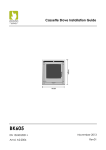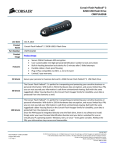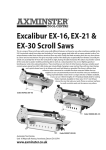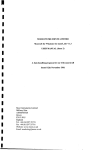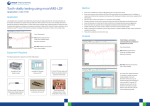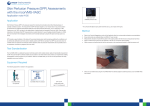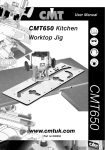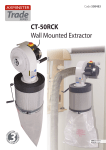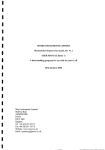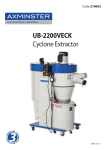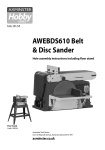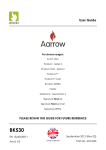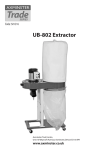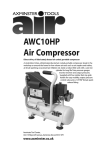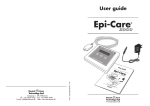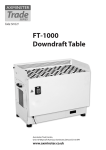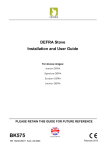Download AE 010 M2 Instructions.cdr
Transcript
AxminsteR SERIES 2 AE 010 M2 Movement Monitor and Sensor Infant and Non Infant Versions Infant version suitable for ages up to 2 years Non Infant version suitable for ages over 2 years Instruction Manual Warnings and Safety Notices 2 This symbol indicates there are warnings and precautions associated with the use of this equipment. This instruction manual should be carefully read and understood before using the equipment. Ensure that the senor cable is routed and secured to avoid the risk of entanglement or strangulation. The equipment will detect movements of the chest/abdomen caused by breathing effort and for this reason the equipment cannot detect air way obstructions or obstructive apnoea. The equipment must not be used in an environment subject to movement such as a moving vehicle, rocking crib, etc or in rooms subject to vibrations. Strong draughts blowing over the cot/bed may be detected as breathing movements by the equipment and delay or prevent the alarm from sounding. Avoid the use of fans directed towards the cot/bed. Ensure that all vibration and movement sources are eliminated before using the monitor and carry out the confidence check as described in these instructions. Ensure, by testing, that the alarm sound from the monitor is clearly audible from the carer's location(s) and against any background sounds that are likely to occur. To ensure that the monitor is operating make a point of observing that the green detection light flashes as movements are detected, in addition carefully observe the check sequence of the indicator lights and sounder when the monitor is turned on and off. Do not use the monitor with two or more babies/occupants in the same cot/bed. To monitor two or more babies/patients they must each have individual cots/beds and monitors. Ensure that the cot/bed used for monitoring is separated from any other cot or bed to prevent the transfer of movement which could otherwise delay or prevent an alarm. The sensor must only be used under the cot/bed mattress and not in direct contact with the baby/patient. Carers should be trained in resuscitation so that they can respond appropriately to an alarm situation and so that they can correctly identify when and how to carry out resuscitation. Only use AA alkaline batteries with the monitor. Do not mix old and new batteries. Do not use rechargeable batteries. Do not attempt to use any form of external power source such as an AC adapter. It is not recommended to use the infant version of the monitor for patients above the age of 2. Generally older patients have slower heart rates which may be incorrectly detected as respiration movements by the infant version. For older patients use the 'Non infant' version. As with all medical electronic equipment there is potential for the equipment to interfere with or be effected by interference from other electrical or electronic devices. For this reason avoid placing the monitor, sensor or connecting cable in close proximity to sensitive electronic devices or devices which produce strong electromagnetic fields such as radio transmitters, mobile phones or power cables. Only use the monitor with accessories approved for use with this product and only in accordance with instructions. If the equipment is modified in any way, appropriate inspection and testing must be conducted to ensure continued safe use of the equipment. Introduction The Axminster AE 010 M2 is a battery operated movement monitor used to detect movements of a baby/patient whilst in a cot/bed. The sensor supplied which connects to the monitor, is positioned under the cot/bed mattress on top of a firm, rigid and flat surface, and detects the movements which are transferred through the mattress. The system will detect movements, predominantly respiration, and provide an alarm after a pre set period should the movements cease. Optionally the monitor can provide an alarm should the number of movements detected fall above or below pre set limits counted over a rolling one minute period. As an additional option the monitor can also detect larger jerking or 'spasm' type movements and provide an alarm if the number of 'spasm' movements exceed a given rate of recurrence for a given period of time. This feature can assist in detecting the symptoms of a clonic seizure. Rear Label Caution consult accompanying documents 2 x 1.5V AA LR6 Alkaline Manufacturers Name & Address Product version Infant or Non infant Front Panel Serial number (First 2 digits year of manufacture) Tick volume up and down Press to reset alarm when sounding Press for more than 2 seconds to turn monitor on. Press for more than 3 seconds to turn monitor off. ON OFF Alarm/Data Connection on side of monitor. Green movement detection indicator. Short flash - Breathing Long flash - Spasm Yellow battery low indicator. Sensor input. Plug the sensor into this socket. 3 Alarm sounder and Red indicator light. Red light Steady on breathing movement cessation Red light Slow Flashing Slow breathing rate Red Light Fast Flashing Fast breathing rate Red Light Steady on + Flashing Detection light Spasm Preparation Before Use Fit batteries (see section on 'Batteries’ page 6) if not already fitted. Place the Sensor, printed side uppermost, on a firm flat surface UNDER the cot or bed mattress so that it will be below the chest/abdomen. Route the sensor cable so as to avoid the possibility of entanglement with the baby/patient and secure as necessary. Ensure that thick bed clothes are not tucked under the edges of the mattress so as to lift the underside of the mattress away from the Sensor. Plug the Sensor into the 'Sensor Input' socket on the Monitor. The monitor should be placed on supporting surface next to the cot/bed such as a bedside table. Directions for use Switching on When the baby/patient is in the cot/bed turn the monitor on by pressing the ‘Power On’ button for 2 or more seconds and observe the green-red-yellow-beep sequence. When monitoring, make a point of observing the green detection light flashing as movements are detected. Audible Tick As an additional verification that the monitor is operating make use of the ‘Tick’ feature which produces a ‘tick’ sound as each movement is detected. The ‘tick’ volume can be increased with each short press of the ‘Tick vol up’ button or decreased (and ultimately turned off) with each short press of the ‘Tick vol down’ button. The tick volu me setting has no effect on the volume of the alarm. Switching Off Turn the monitor off at the end of a monitoring period by pressing the ‘Power Off’ button for 3 or more seconds. The monitor will quickly flash all of the indicator lights and beep 3 times. Movement cessation Alarm If no ‘breathing’ type movements have been detected there will be a pre-warning 'beep' 5 seconds prior to the main alarm, this feature is designed as a reminder to turn the monitor off (the monitor can be supplied with the pre-warning beep feature disabled). After the pre set alarm time (normally 20 seconds, but other times available) a pulsating alarm will sound and the red alarm light will illuminate. If normal movement resumes, the alarm sound will cancel* but the red light will remain on for 1 minute to indicate the alarm was activated. * The alarm will not cancel if the optional latching alarm feature has been enabled. 4 Movement Rate Alarm(optional) The monitor counts the number of breathing type movements detected over a rolling one minute period. The monitor can be supplied to alarm if the number of movements exceed and/or fall below set limits. If the number of movements detected falls below the lower set limit a pulsating alarm will sound and the red alarm light will flash slowly. If the number of movements detected exceeds the higher set limit a pulsating alarm will sound and the red alarm light will flash quickly. If the movement rate returns within the set limits the alarm sound will cancel but the alarm light will continue to flash for a further one minute period or until reset by the ‘Alarm Reset’ button. Spasm Alarm (optional) The monitor can be supplied to detect body jerking/spasm type movements. These movements are indicated by a prolonged flash of the green detection indicator. If these movements exceed a given rate of recurrence for a given period of time then a pulsating alarm will sound and the red alarm light will illuminate together with a rapidly flashing green detection indicator. Cancelling Alarms Any active alarm can be cancelled immediately by pressing the ‘Alarm Reset’ button. The alarm reset feature temporarily cancels the alarm, and should the condition causing the alarm persists then the alarm will reactivate. Battery Low The battery low indicator will flash and the Monitor will produce a quiet 'chirping' noise when the batteries are nearing the end of their life. When the battery low warning is given, replace the batteries. The monitor will typically operate for up to 12 hours whilst the battery low indicator is flashing but it is important to replace the batteries as soon as possible, it is advisable to keep a set of new batteries for such an occasion. The low battery warning is disabled during any alarm condition. Confidence Check It is recommended that the confidence check is carried out prior to a period of monitoring to ensure that the alarm function is working, this also checks that normal room vibrations do not inhibit the alarm. Switch on the Monitor with the cot/bed vacant, stand still (particularly if it is a room with a bouncy floor), and check that, after the alarm delay period (normally 20 seconds, but other times available), a pulsating alarm will sound and the red alarm light will illuminate. Five seconds before the main alarm, the pre-warning 'beep' sounds (The Monitor is available with the pre-warning 'beep' disabled). Check that the alarm sound from the monitor is clearly audible from the carer’s location(s) and against any background sounds that are likely to occur. Cancel the alarm by pressing the ‘Alarm Reset’ button and switch the monitor off. Additional Information Mattress The Sensor detects movements through the mattress. This extends the range over which the baby/patient may move and still allow effective monitoring, for best performance, this should be of a foam construction. The bottom of the cot or bed on which the Sensor is placed must be firm and flat, otherwise it will not work effectively when placed on an uneven or soft surface. Where the cot or bed has wire springs, a resilient under mattress beneath the top mattress, or wooden slats, it is advisable to place the sensor on top of a rigid 6mm board (plywood or MDF) cut to the full size of the mattress base. 5 It is recommenced to regularly turn the mattress over, as well as extending the life of the mattress, it also prevents the mattress taking the shape of the sensor and reducing the sensitivity. Service, Maintenance & Storage Batteries To replace or fit the batteries, unscrew the single battery cover retaining screw on the rear of the monitor and lift off the cover. Remove and dispose of any old batteries carefully in accordance with local regulations (do not incinerate or dispose of in a manner that could be harmful to the environment). Fit two new alkaline AA, LR6 batteries, checking the polarities are correct, as shown in the base of the battery compartment. Ensure that the battery terminals are pressing on the batteries and are not loose. Locate the battery cover and secure the retaining screw. Use only alkaline batteries and do not mix old and new batteries. Cleaning Do not spray, pour, or spill any liquid on the equipment or its openings. Do not immerse in liquids. The Sensor can be cleaned by wiping with cotton wool pads moistened (compressed until dripping stops) with a mild detergent (0.5% washing up liquid) solution. The Monitor may be cleaned by dusting with a soft brush and/or wiping with cotton wool pads moistened with a mild detergent solution. Alternatively baby wipes can be used instead of the cotton wool/mild detergent. The sensor cable and plug can be cleaned by wiping with disposable 70% isopropyl alcohol wipes. Ensure that the sensor pad plug is completely dry before reinserting into the sensor input socket on the monitor. To perform a low level disinfection after cleaning, wipe exposed surfaces of the monitor and sensor with disposable 70% isopropyl alcohol wipes. Servicing Servicing can be carried out by returning the equipment to Axminster Electronics Ltd or the service departments of authorised distributors. We recommend that the monitor is serviced every 12 months as a means of ensuring that the monitor’s functions are operating within specification. A service manual is available from Axminster Electronics Ltd upon request to service departments and their personnel. Storage Remove the batteries if the Monitor is not being used for a prolonged period, because old/flat batteries can leak causing damage. Store the monitor and sensor in a clean, dry place away from sources of heat. 6 Problems False alarms. If the Monitor fails to detect breathing movements, check the position of the Sensor and/or the type and thickness of mattress, but note that any problem will usually manifest itself during shallow breathing at 3am! Read carefully the sections on 'Mattress' and 'Preparation before Use'. If baby/patient is regularly moving away from the sensor it is possible to connect a second Sensor to your monitor with an adaptor to increase the detection area, please contact your supplier for details. Green Indicator not Flashing, Monitor Alarms. If the Monitor wi ll not detect any movements, check the Sensor is fully plugged in. If after checking this and the green indicator does not flash when the Sensor is touched every 1-2 seconds, there is possibly a Sensor or Monitor fault; contact your supplier, also check the wire to the Sensor Pad has not been damaged, possibly by being trapped in the cot/bed. Monitor will not complete the Power on Sequence. If th e Monitor will not complete the Green-Red-Yellow-Beep 'Self Test' after pressing the power button for 2 seconds, or misses part of the sequence, try replacing the batteries. If this does not clear the problem contact your supplier. Movements Detected with Vacant cot/bed. Check that the cot/bed is not touched or subject to movement such as motorised devices, strong drafts etc. If the cot/bed has just been vacated then the monitor may be detecting movement in the mattress as it recovers to it’s uncompressed position, in which case wait a few minutes and repeat the confidence check on page 5. If the floor in the room that the cot/bed is subject to movement then reposition the cot/bed nearer to a solid supporting wall. Monitor Will not Function at all. If the Monitor appears 'dead', check that the batteries are located correctly and making firm contact. Try replacing with new batteries. If this does not clear the problem contact your supplier. Guarantee If the equipment becomes defective due to faulty materials or workmanship at any time within 12 months from date of purchase, we guarantee to either repair or replace the defective parts free of charge, excluding normal wear and tear. Provided: 1. The equipment has not been misused or carelessly handled. 2. Repairs have not been attempted by persons other than our Service Staff or Authorised Distributors Staff. This guarantee is offered as an extra benefit and is in addition to your statutory rights. This guarantee may be extended to 24 months free of charge by simply filling in and returning the customer feedback form within the first year of purchasing the monitor. 7 Specifications Dimensions Monitor 120x65x23mm Sensor (AE 020 S) 175x175mm Sensor (AE 030 S) 240 x 240mm Mass Monitor 80g (excluding batteries) Environment Operational, Transport and Storage temperature must not exceed the range 0ºC to 40ºC. Batteries Two Alkaline 1.5V AA size, LR6 batteries. Battery life approximately 6 months under normal use of 12-14 hours per day. Alarm Delay Normally set to 20 seconds but available with settings from 10 to 60 seconds. The pre-warning 'beep' will occur 5 seconds before the main alarm (Optional). Rate Alarms (Optional) Fast movement rate Alarm with settings from 45 to 65 (infant) or 20 to 30 (non infant) movements per minute. Slow movement rate Alarm with settings from 10 to 35 (infant) or 5 to 20 (non infant) movements per minute. Spasm Alarm (Optional) Alarms with spasm movements > adjustable 12 to 120 per minute frequency lasting > adjustable 5 to 60sec. Alarm/Data Output Maximum cable length 3m. Optional 3V logic output, normally low. Serial Data 9600bps 8 data bits 1 stop bit No parity. Sound Output Available in range 70 to 85dBA @ 1m typical SPL. Accessories Order Code AE 020 S AE 030 S CEL 1500 CNL 0101 CON 1435 Description Sensor 175mm x175mm (Standard sensor). Sensor 240mm x 240mm (Large sensor). Alkaline Battery, Size AA, LR6 1.5V (2 Required). Normally open, open collector output adaptor lead. Sensor input adaptor, for connection of a second sensor. Axminster Electronics Ltd Weycroft Avenue Millwey Rise Industrial Estate Axminster Devon EX13 5HU 8 Telephone: 01297 32360 [email protected] Protect the environment! This electronic equipment contains reusable material and must not be disposed with domestic waste. Please take it to a collecting point for electric and electronic equipment (ask your local authorities for details). Issue 1 LAB 0102








